MARIANI’S
Virtual
Gourmet
November
8, 2020
NEWSLETTER
Founded in 1996
ARCHIVE
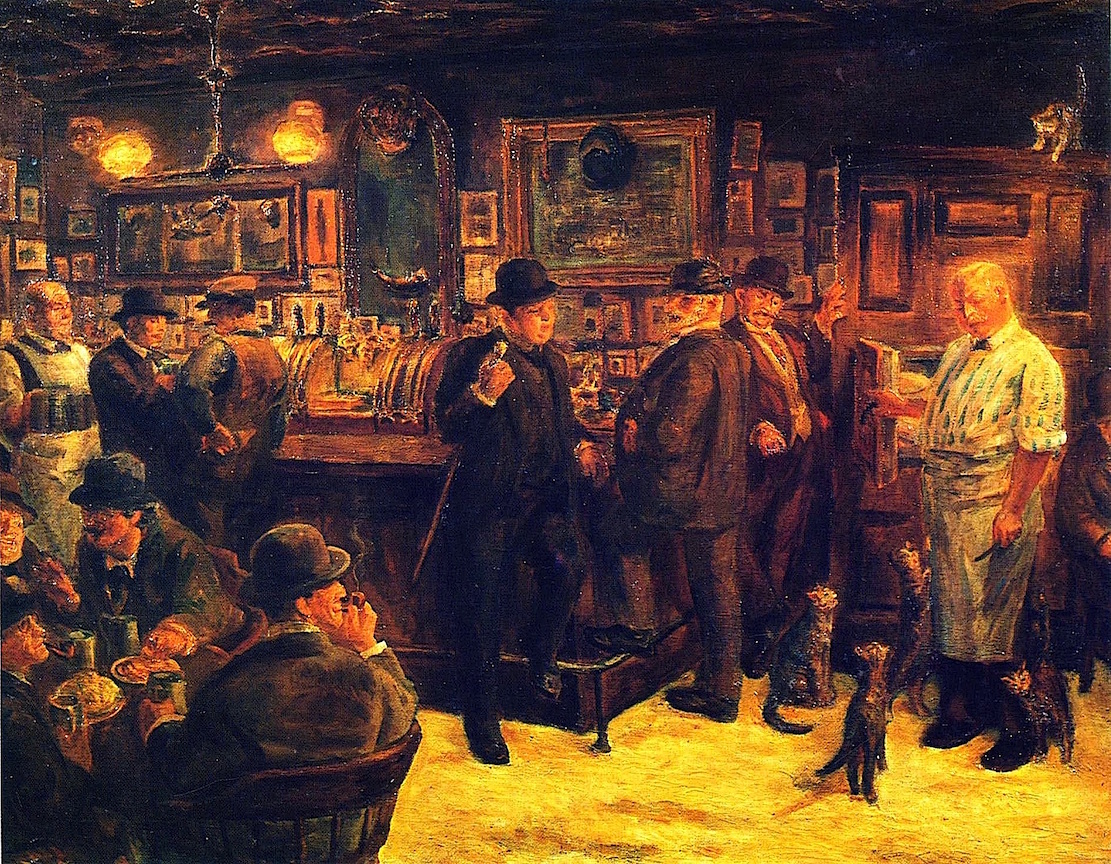
"McSorley's Tavern" (1928) by John Sloan
IN THIS ISSUE
WHO GETS WHAT?
AN INTERNATIONAL GUIDE TO TIPPING
By John Mariani
NEW YORK CORNER
LOVE AND PIZZA
Chapter Thirty-Three
By John Mariani
NOTES FROM THE WINE CELLAR
WINES FOR THANKSGIVING
By Geoff Kalish
❖❖❖
WHO GETS WHAT?
AN INTERNATIONAL
GUIDE TO TIPPING
By John Mariani
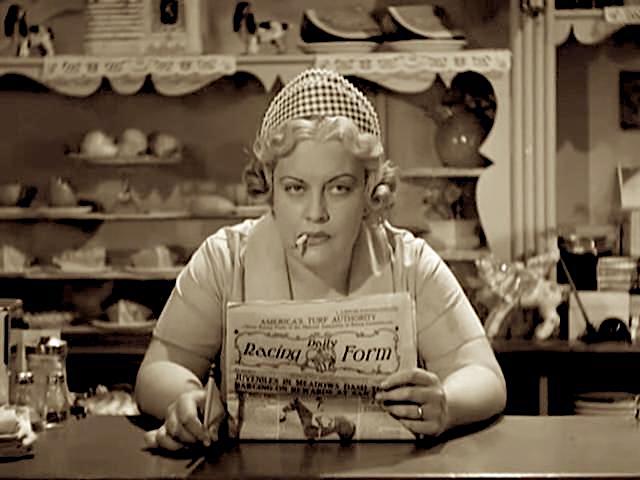
Nothing, save
drinking the water in Tijuana, causes travelers
more anxiety than the vagaries of tipping. I
have sat across dining tables with some of the
best-traveled, most sophisticated people in the
world who start to tremble when they have to
write in a gratuity on the bill. I’ve seen CEOs
who barely shrug when faced with a Senate
sub-committee investigation in the afternoon go
to pieces contemplating the tip at dinner that
evening.
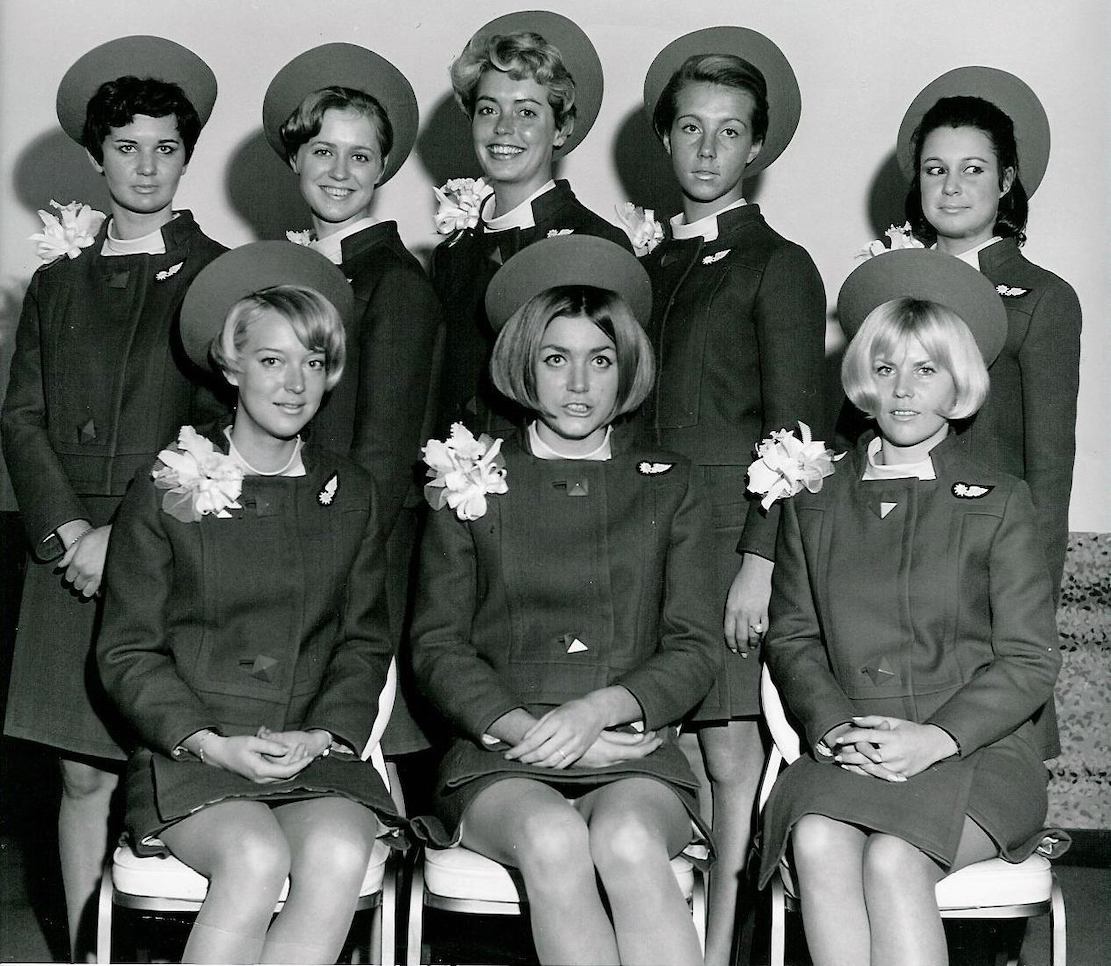 I admit, tipping is a
tough business. And a completely stupid one,
defended on the one hand by those who choose not
to pay a decent wage to their employees, and on
the other by those same employees who both need
the money and who love the feel of cash in their
pocket. (For the record, I have waited tables and
loved the cash, too.) But why do we tip waiters,
porters and valet parkers but not flight
attendants, salespeople at a shoe store, check-out
workers at a supermarket, or mechanics at a full
service gas stations—none of whom makes much more
than minimum wage? There seems no rhyme or reason
to it, except entrenched tradition. ( By the
way, the word “tip” is not an
abbreviation for “to insure promptness.”
“Gratuity” precedes “tip” in print by two hundred
years, around 1540.)
I admit, tipping is a
tough business. And a completely stupid one,
defended on the one hand by those who choose not
to pay a decent wage to their employees, and on
the other by those same employees who both need
the money and who love the feel of cash in their
pocket. (For the record, I have waited tables and
loved the cash, too.) But why do we tip waiters,
porters and valet parkers but not flight
attendants, salespeople at a shoe store, check-out
workers at a supermarket, or mechanics at a full
service gas stations—none of whom makes much more
than minimum wage? There seems no rhyme or reason
to it, except entrenched tradition. ( By the
way, the word “tip” is not an
abbreviation for “to insure promptness.”
“Gratuity” precedes “tip” in print by two hundred
years, around 1540.)
The
rules have been changing. It used to be in
the U.S. that you didn’t tip a full 15% on
beverages, now it’s expected. The question
is, if you can afford to spend $500 on a bottle of
wine, would you balk at a $50-$60 tip on that
bottle? Most of us don’t drink that high, so
the tip on the bill is somewhat easier to
swallow.
For the most part, we have only ourselves
to blame, because American tourists, goaded by
naiveté and misguided travel writers, tend to tip
everyone within fifty yards of a hotel, restaurant
or car park—even
when the service is included. I
have also noticed that American travel magazines
give wholly erroneous information about local
customs, recommending everyone on a service staff,
from door man to chamber maid, from concierge to
waiter, should be tipped and tipped lavishly. It
simply ain’t the case.
Let me try to help
by giving some reasonable guidelines that still
make sense around the world.
UNITED STATES
Restaurants
For good service 15% is still the
norm around the country, for superior service,
20%, but the latter has increasingly been
recommended by big city spenders, and some
guilt-ridden customers go to 25% or 30%. Good for
them, but then, why not 50%? Will you get love in
return? 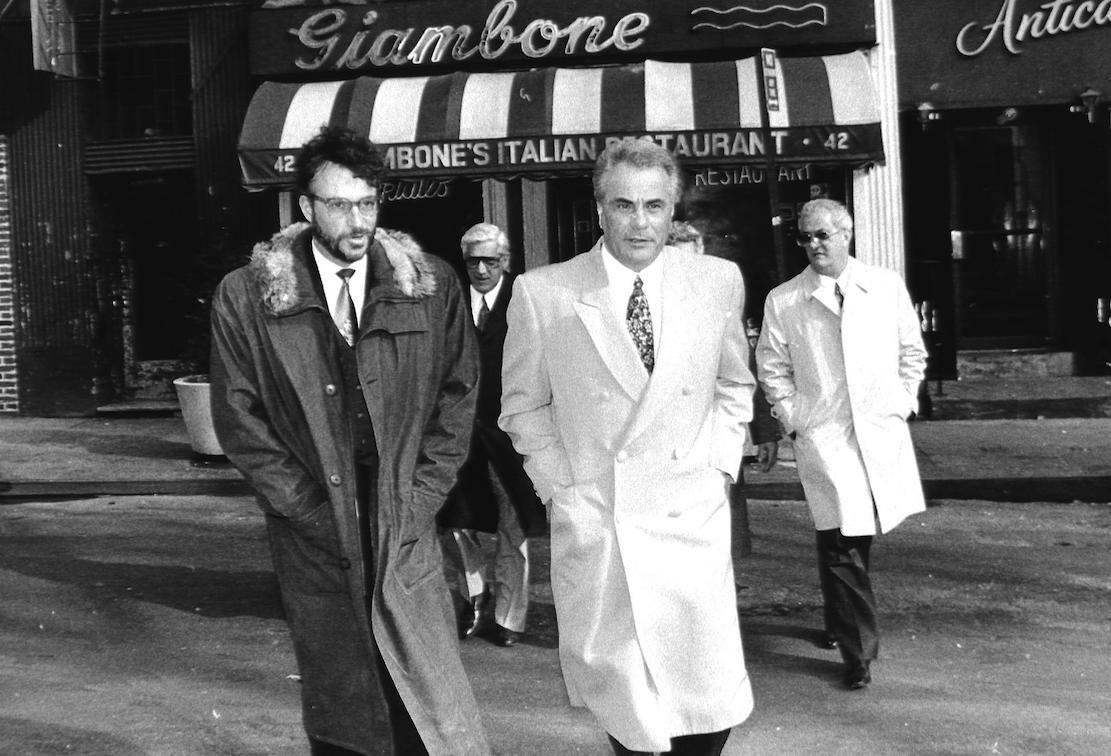 If that’s what you crave, flash
that cash!
If that’s what you crave, flash
that cash!
The late New York plumbing executive John
Gotti used to ensure extra special suck-up service
by doubling the amount of the bill for a tip at
restaurants—always obtaining the best table with
his back to the wall. It was a sad day for
New York waiters when the Feds sent the Dapper Don
to the slammer, where his meals were provided
through a slot in his cell door—service included.
There’s no question that the waiter in a
low-priced restaurant deserves more consideration
when the bill only comes to $22, but in high-end
restaurants, which include steakhouses all around
the country, a waiter can easily make $60,000 to
$90,000 a year in salary and tips; on an average
night at a bar where the drinks cost $20 a
bartender can pocket $300-$500 easily.
In the U.S. the wine steward is
tipped—preferably in cash—only if he has performed
exceptional services, like choosing several wines
for a multi-course meal or decanting old vintages;
then, you may
want to tip him $5-$20 in cash.
 The
maître d’ is tipped upon leaving only if
he provided a special service like getting you a
specific table you requested, arranged for a
birthday cake, or notified you that your ex-wife
or current husband is in the dining room. Never, ever
grease his palm upon entering, which will mark you
as a patsy. It is rare these days, but some
restaurants, like Joe’s Stone Crab in Miami Beach,
are notorious for maître d’s who expect a twenty
or fifty-dollar bill just to get you a table at
all in high season.
The
maître d’ is tipped upon leaving only if
he provided a special service like getting you a
specific table you requested, arranged for a
birthday cake, or notified you that your ex-wife
or current husband is in the dining room. Never, ever
grease his palm upon entering, which will mark you
as a patsy. It is rare these days, but some
restaurants, like Joe’s Stone Crab in Miami Beach,
are notorious for maître d’s who expect a twenty
or fifty-dollar bill just to get you a table at
all in high season.
The
coat check has for decades been getting a dollar
per item, so it may be time to make five dollars a
minimum. As for parking valets—otherwise known as
holdup men—tip whatever you think is enough to get
your car quickly and back in one piece. In Los
Angeles, the valet companies exact a charge, on top of
which many of my Los Angeleno friends always tip
extravagantly, fearful that the valet might in the
future scratch their cars if they don’t.
By the way, European visitors are known not
just for their stinginess with tips but their
feigned ignorance that one should do so at all,
despite every foreign tourist having read a guide
book that says otherwise.
Hotels
Once
again, Americans tip everyone in sight. Here are
some guidelines, depending on the prices in the
hotel. Doormen are tipped 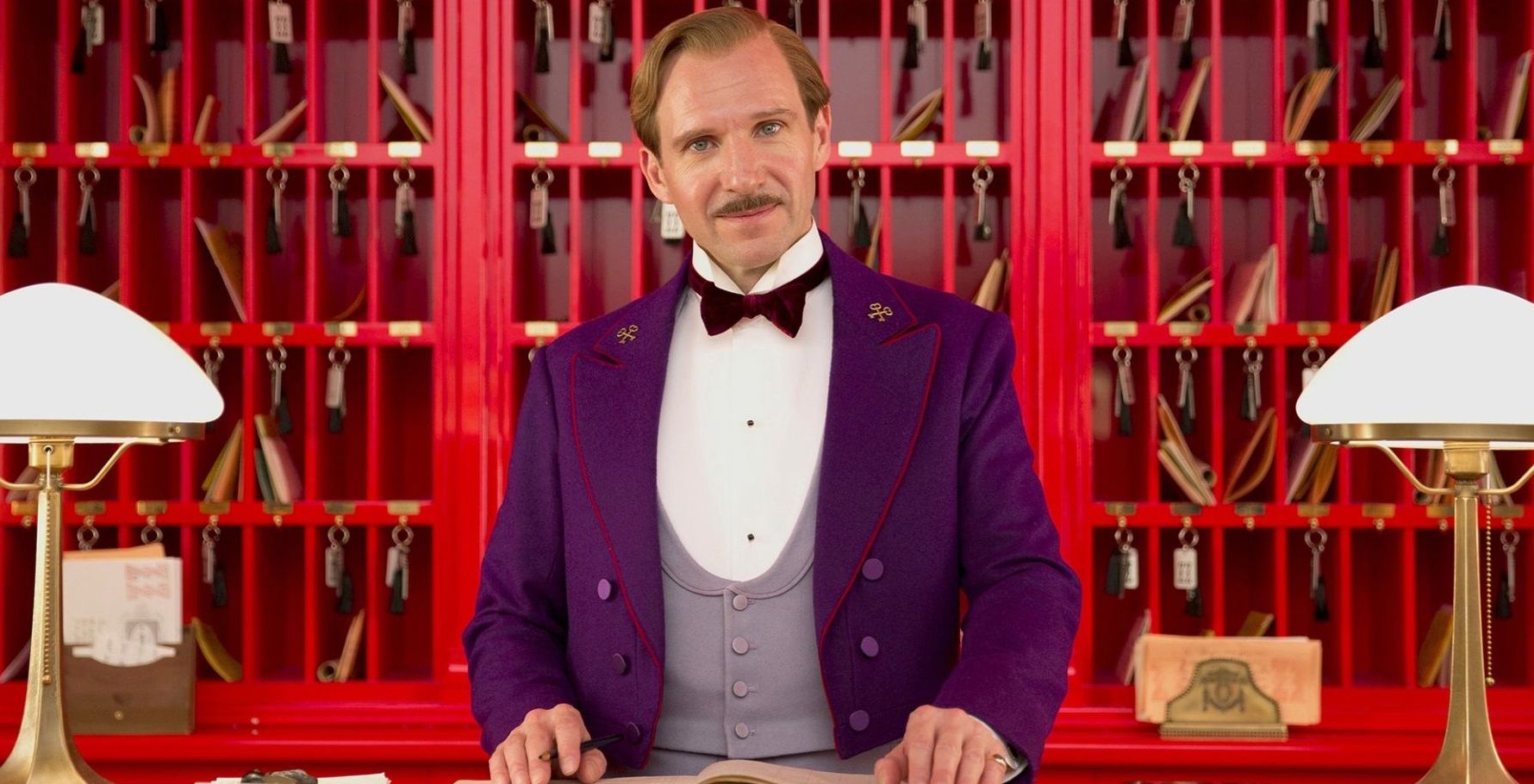 if
they help unload your luggage, although the
porters bristle when they do that, because they do
expect a tip. Notice how the porters never bring
your luggage to your room as you check in but only
bring it up after you’re in your room, thereby
assuring you tip them when they knock on your
door. One way or another, a dollar or two per bag
is normal in most places.
if
they help unload your luggage, although the
porters bristle when they do that, because they do
expect a tip. Notice how the porters never bring
your luggage to your room as you check in but only
bring it up after you’re in your room, thereby
assuring you tip them when they knock on your
door. One way or another, a dollar or two per bag
is normal in most places.
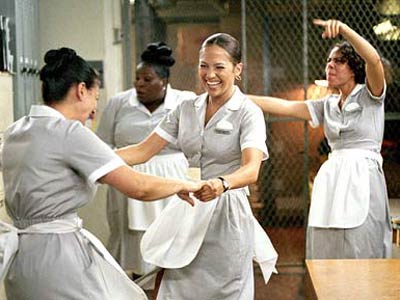 Room service is the biggest
gouge hotels can charge (even though they say room
service makes no profit). Every room service bill
contains a service charge, which is never less
than 15% and sometimes above 20%, so an extra tip
is not required, especially since the room service
waiter did nothing but roll a cart into your room
and take the lids off the food.
Room service is the biggest
gouge hotels can charge (even though they say room
service makes no profit). Every room service bill
contains a service charge, which is never less
than 15% and sometimes above 20%, so an extra tip
is not required, especially since the room service
waiter did nothing but roll a cart into your room
and take the lids off the food.
It is traditional in the U.S. to tip the
chambermaid, and I think that generosity is the
way to go in this case. Five dollars a day is a
good tip, if the service throughout your stay has
been what you expect. Coming back to an un-made-up
room after 3 p.m. is not my idea of good service.
Generally speaking,
tipping is wholly
unnecessary in most European countries,
where “service included,” “servizio
incluso” or “service
compris” appears on checks, along with a VAT
charge that may be 15% to 25% depending on the
country. Restaurants, however, have gotten a
break in recent years, so the VAT in Belgium is
now 6% (except for alcohol); Finland 14%; France
10%; Germany and Hungary, 5%; Ireland is 13.5%; up
until last week, Italy had no VAT on restaurant
purchases but may go to a 10% VAT. For rates, go
to:
https://www.avalara.com/vatlive/en/vat-rates/european-vat-rates.html.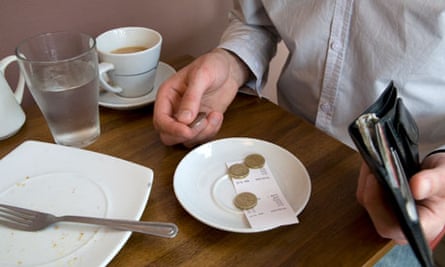
Nevertheless, Americans feel squeamish in
Europe not leaving a tip on top of the service
charge (and some tip on top of the VAT, too!). I
have asked my friends in France, Italy, Spain and
elsewhere about tipping in restaurants again and
again, and no one says it’s necessary. If they
felt a staff member was particularly outstanding,
a tip in cash of five or ten euros might be
proffered; otherwise, no.
What, then, is the French pour boire? It
is the tradition of leaving excess change or a
couple of euros on the table or rounding off the
bill. (The term actually translates as “for a
drink,” so that the server can have himself
one.) The same is true in most
other European countries.
Taxi drivers do not expect a tip in Europe,
though rounding off a charge of, say, 9.50 euros
to 10 euros is a nice gesture.
At hotels, there is a tendency to tip
porters, but a euro or two is sufficient.
Concierges can work miracles upon request and
should be tipped upon leaving with an envelope of
cash; getting you a restaurant reservation is not
a miracle; getting you into a three-star
restaurant on short notice is.
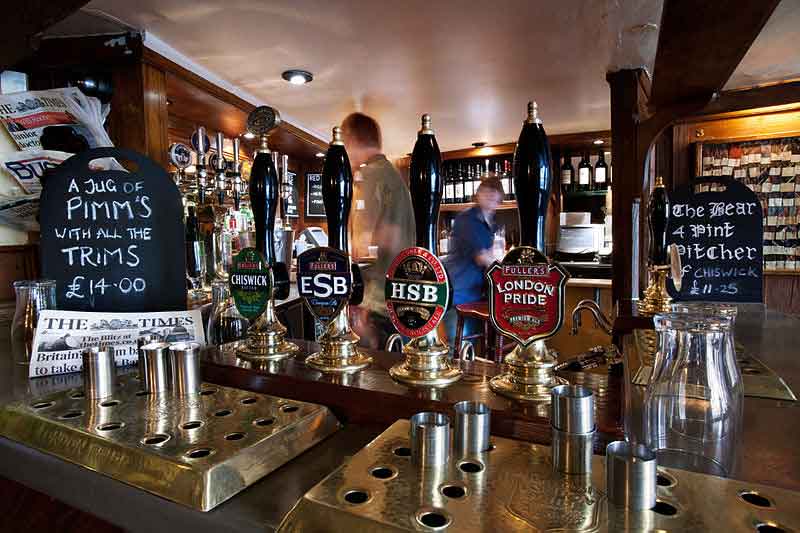
Things are different in the
UK and Ireland. The rules have in the past been
closer to American tipping ritual, though the
gratuities are lower, between 10% and 15% for
restaurant service. On recent trips to London I
have found more and more restaurants adding a discretionary
service charge of about 12.5%, so check your bill
carefully and tip accordingly if you must.
Tipping used to be discouraged in British
pubs until recently; some even had signs reading
“NO TIPPING,” but now some publicans encourage it.
Look around and see what the Brits are
doing. Neither do you tip on pub food.
I read on one travel website that, “If the doorman hails you a
cab, a tip of 1 to 5 pounds is appropriate,
depending on how luxurious the hotel is.” It
would have to be a pretty damn luxurious hotel
to tip a guy who hails your taxi five pounds
($6.50).
Housekeepers do not expect a tip (unless
you’re an American), but it is cordial to do so,
perhaps a few pounds when you leave.
Taxi drivers are fine with a rounded-up
fare.
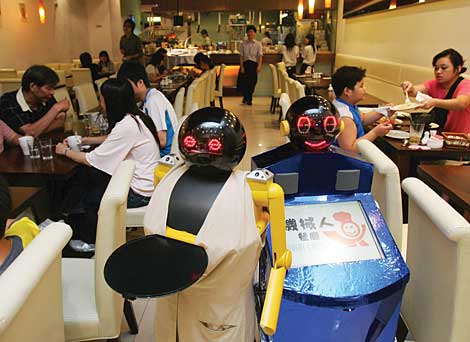
The differences from
country to country make general statements
impossible and specific guidelines too lengthy for
inclusion here. Ask at the local tourist office
what customs suggest. In Istanbul there is
always a 10% service charge on restaurant bills,
with a 10% gratuity customary. Until recently in
Israel no one expected a tip, but it’s now
customary to leave 10% at a restaurant.
In Hong Kong a 10% tip used to be the norm
at a modest restaurant, while upscale dining rooms
usually added 10% to the bill. Now that
Communist policy governs such things, tipping is officially
discouraged as capitalist bribery. But few
Chinese these days will refuse a tip (or fear jail
time for such an offense); nevertheless, be
careful about throwing around cash. Some
modern restaurants now tack on a 15% service
charge.
Singapore also frowns upon tipping, despite
the fact that the 10% service charge doesn’t
always go the waitstaff. This is also true in
Bangkok, where gratuities are not expected at
hotels or restaurants.
In Japan, where a 10% service charge is
usually on the hotel and restaurant bills, tipping
is truly considered bad form and an embarrassment,
so keep your hands in your pockets!
 AUSTRALIA
AUSTRALIA
Civilized country that it is, Australia does not exact a service charge, and until recently tipping was not the norm. Sad to say, it is becoming so, so you might want to leave 5%-10%. on a restaurant bill.
❖❖❖
By John Mariani
LOVE AND PIZZA
Since, for the time being, I am unable to write about or review New York City restaurants, I have decided instead to print a serialized version of my (unpublished) novel Love and Pizza, which takes place in New York and Italy and involves a young, beautiful Bronx woman named Nicola Santini from an Italian family impassioned about food. As the story goes on, Nicola, who is a student at Columbia University, struggles to maintain her roots while seeing a future that could lead her far from them—a future that involves a career and a love affair that would change her life forever. So, while New York’s restaurants remain closed, I will run a chapter of the Love and Pizza each week until the crisis is over. Afterwards I shall be offering the entire book digitally. I hope you like the idea and even more that you will love Nicola, her family and her friends. I’d love to know what you think. Contact me at loveandpizza123@gmail.com
—John Mariani
To read previous chapters go to archive (beginning with March 29, 2020, issue.
LOVE AND PIZZA
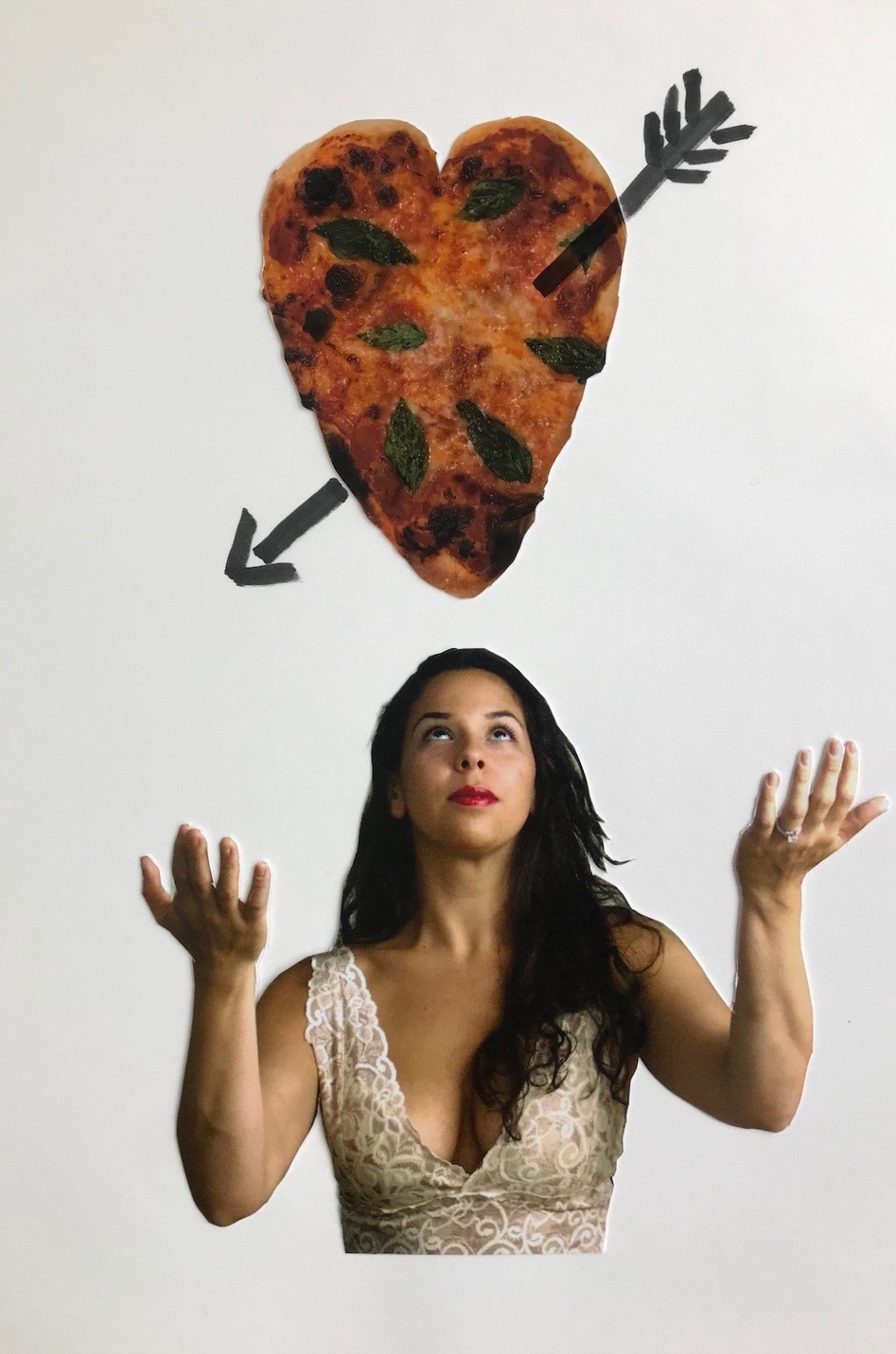
Cover Art By Galina Dargery
Chapter Thirty-Three
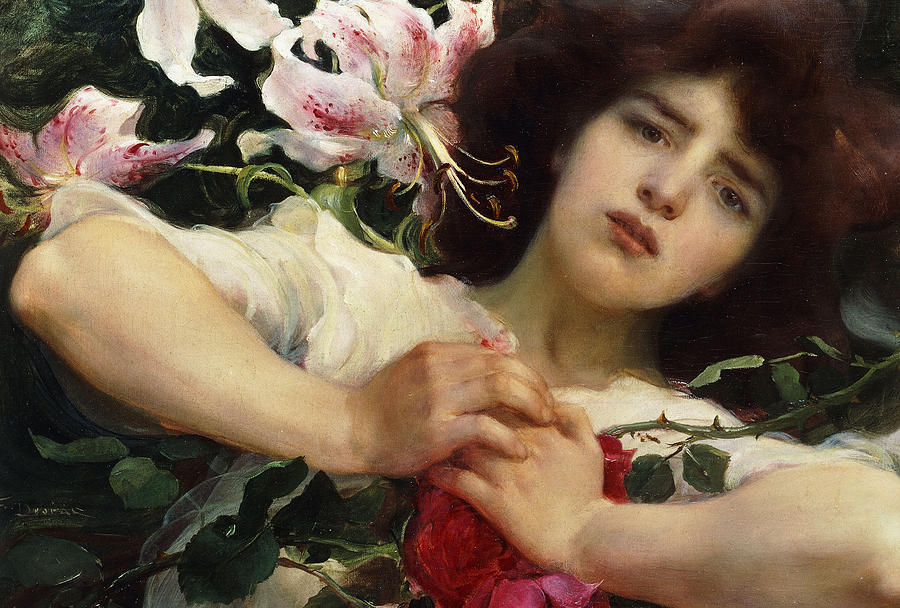
"Purity and Passion" (c. 1907) by Franz Dvorak
It would be only two more weeks
before the semester in Milan ended, and in
that first week Giancarlo called her every
night, still holding out some hope he might
be able to cancel business plans and spend
the weekend with her. Despite
Nicola having final exams the following
week, she made sure her studying would not
preclude her time with Giancarlo.
Then, on Thursday night, around seven,
Giancarlo called, sounding miserable. “Cara,”
he
said, “I am so sorry but I am not going to be
able to come to Milan tomorrow.”
“What? But yesterday you said it looked
good.”
“I know, I know. I
thought so too, but one of our German clients
here in Rome has thrown—how do you say it?—a
monkey wrench into our negotiations, and I
have to be here through the weekend.”
Nicola thought fast. “Well, what about
if I take the train to Rome? We
can spend Friday and Saturday nights
together.”
There was a pause on the other end of
the phone that lasted long enough for Nicola
to ask, “Hello? Giancarlo, are you still
there?”
“Yes, Nicolina, I’m still here. But it
is not going to work. I
promised my father I would not come back to
Torino until I had this deal all worked out,
and these bastards are playing very rough,
trying to get out of a deal that—”
“I don’t care what kind of deal it is,
Giancarlo,” Nicola screamed into the phone. “You
can’t work all night long!”
Giancarlo sounded a little heated now. “Nicola”—not
Nicolina—“I have no time to play when things
are this serious. I can’t show up looking like
I just got out of bed with you.”
Nicola almost choked. “No time to play?
That’s
what you think we do in bed? God
forbid you should miss a little sleep so you
won’t look bad in front of the goddamn
Germans!”
The two of them went back and forth,
shouting then tempering their responses,
finally speaking softly to each other.
“Giancarlo, you know if I don’t see you
this weekend, I don't see you at all for a
long time.
That’s not a threat, it’s a fact. I go
home in a week and you said you’re on the road
till the middle of May. How
is this all going to work out?”
She could hear Giancarlo breath in
deeply, then say, “I don't know, Nicolina. All
I know is that I am very depressed about this
and want to see you very, very much, as soon
as possible, and I swear to you that when I am
finished with all this bullshit, I will fly to
New York, I’ll take a vacation, and we will
have plenty of time together.”
To herself Nicola said, “I’ll believe
it when I see it,” but told Giancarlo, matter
of factly, “Then that’s the way it’ll have to
be, I guess.
I will wait for you in New York.” Giancarlo
heard sniffling.
“That’s all I can do,” said Nicola,
hoping he would respond forcefully, “That’s
all we
can do.” But instead Giancarlo said, “I
suppose so, Nicolina. But
it will be wonderful when we see each other
next month, eh?”
They spoke until there was nothing left
to say, both closing with “arriverderci”
rather than “ciao.”
Nicola sat on the edge of her bed and
broke into tears. Then
she took the art history book she’d been
reading and threw it against the wall. Then
for some stupid reason it occurred to her that
her time in Italy had ended not with a bang
but with a whimper. She
almost laughed at the thought.
One week later, her exams
over, Nicola packed to return home with the
other students.
Catherine, Jenny, Suzanne and Mercédes,
to varying degrees, were looking forward to
going back, though each vowed to return to
Italy as often as they could. For
if its beauty had not proven fatal, Italy had
been indelibly absorbed into their character
and changed much of the way they thought about
their lives.
Nicola had not said anything to anyone
except Catherine about the state of things
with Giancarlo.
Down deep Catherine suspected her
friend had botched the chance to impress
Giancarlo’s parents but said nothing. Had
Catherine only been along that weekend she
might have lent Nicola the benefit of her
experience traveling among the upper class. Nicola,
too, felt sure Catherine would have fit right
in, even if her Italian was weak and heavily
accented. Somehow she would have made that
work for her.
In any case, Catherine insisted that
all she heard from Nicola suggested that her
relationship with Giancarlo would again
flourish when he came to New York. “After
all,” she told Nicola, “you’ll have him on
your turf, and from what you’ve told me about
the guy, he loves
your turf.”
“Yes, but then he’s never seen Belmont.
It doesn't exactly look like his villa in Alba
or the neighborhood he lives in in Turin.”
Catherine closed her last bulging
suitcase—there were now seven—and said, “And
here I thought you were a snob, Nick. You’re
not. You’re more ashamed than you are a snob. Snobs
feel superior to almost everyone else. You’ve
got a touch of that. But
like most pseudo-snobs, which is what you seem
to be, you’re really just insecure, like we
all are down deep.”
Nicola took no offense but said, “What
have you
got to be insecure about?”
Catherine rolled her eyes and said,
“Hm, let me count the ways. For
starters, I always have to measure up, to my
parents, my background, my friends, my
parents’ friends—it never stops. Then
I have to measure up to my own self image,
Nick. I
mean, I know I’m smart—not as smart as you
are—and I will succeed in anything I put my
mind to because I’ve got the brains and the
ego, not to mention a lot
of connections.”
“And you’re also damn good-looking,”
said Nicola.
“I guess so, but that’ll fade. And
it gets really bad among my crowd when it
does. The
facelifts never really work out, y’know.
Anyway, I’ll probably always be insecure about
measuring up to my own self-image, not what
people expect of me. So,
like everyone back home, I hide it by looking
down on everyone. Except
you, of course.”
“Thanks, Catherine,” said Nicola. “I
love you, old friend.”
“And maybe that’s the best thing for
women like us, that we grow old together as
good friends from—pardon the
expression—different sides of the tracks.”
“I’ll drink to that,” said Nicola.
“Which reminds me. We’ve got just
enough time to pop over to Paper Moon, grab a
pizza and a bottle of wine.”
“Done deal!”
“By the way, Nick, for
what it’s worth, I won’t be seeing my new guy
at all when we get back. I’ll have to come
back to Italy to see him. Bummer!”
WINES FOR THANKSGIVING
By Geoff Kalish
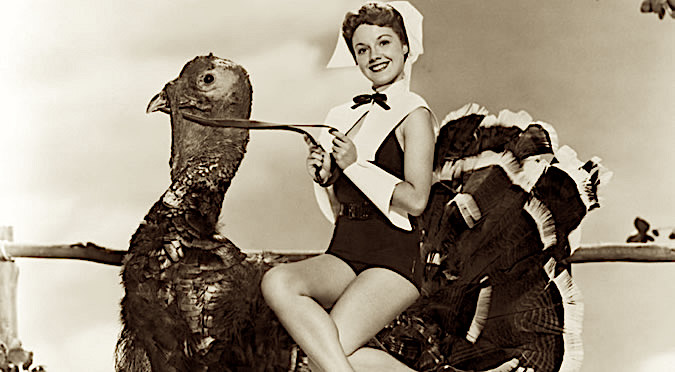
Because of a variety of coronavirus restrictions, it is anticipated that most Thanksgiving dinner gatherings, whether at home, at a relative’s house or restaurant, will be far more limited in size this year. However, it is expected that the traditional turkey and trimmings of stuffing, sweet potatoes, cranberry sauce and the like will still be the fare of choice. And, while some pundits proclaim that any wine you like will do, I have found that the many flavors of the food, especially the sweeter dishes, pose a bit of a challenge. Especially wines from the Cabernet Sauvignon grape, which I find mate poorly with such a meal. Also, I find that bland whites lack the oomph to marry well with the robust flavors of turkey gravy and even mildly seasoned stuffing.
And many
wines made of Chardonnay grapes, especially
those that are very oaky, overwhelm the taste
of turkey, especially white meat, and leave a
jarring taste when mated with cranberry sauce.
So, with this, as well as sensible pricing and
wide availability in mind, I offer the
following suggestions as wines to drink for
Thanksgiving.
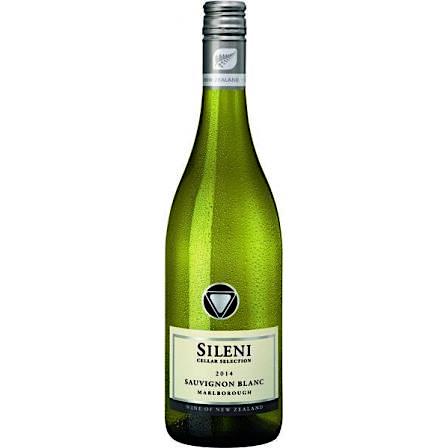 2019 Silleni Cellar Selection
Sauvignon Blanc ($14)—Showing a bouquet and taste of
tropical fruit, gooseberries and fresh lemons, this
wine from New Zealand is named for the ancient Greek
god Dionysus’s companions, whose mission was to
encourage enjoyment of delicious food and wine. Its
fresh taste livens the flavor of most food, even the
blandest stuffing or unadorned vegetables.
2019 Silleni Cellar Selection
Sauvignon Blanc ($14)—Showing a bouquet and taste of
tropical fruit, gooseberries and fresh lemons, this
wine from New Zealand is named for the ancient Greek
god Dionysus’s companions, whose mission was to
encourage enjoyment of delicious food and wine. Its
fresh taste livens the flavor of most food, even the
blandest stuffing or unadorned vegetables.
2019 Rhangleigh Chenin Blanc ($14)—Hailing from the Western Cape
area of South Africa and named after the winner of
the 1914 prestigious Durban July Handicap race,
this wine shows a fragrant bouquet and taste of
ripe pears and melons with notes of honey and a
citrusy finish. While it does not mate that well
with the likes of stuffing, sweet yams and
cranberry sauce, it makes an excellent wine to
serve with hors d’oeuvres like smoked salmon,
bruschetta and toast coated with olive tapenade or
humus.
2018 Beringer Private Reserve
Chardonnay ($37)—From winemaker 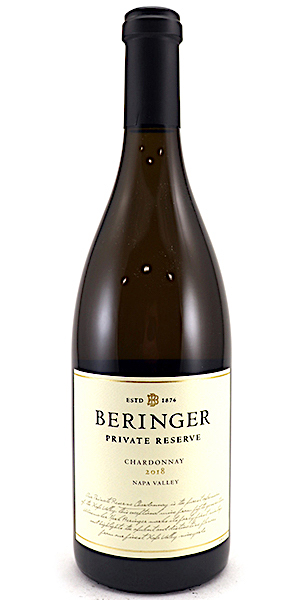 Mark Beringe
(great-great-grandson of winery founder Jacob
Beringer) comes this elegant wine with a bouquet
and taste of baked apples and hints of pineapple
and just enough oak and citrus to marry
harmoniously with turkey and the “fixings.”
Mark Beringe
(great-great-grandson of winery founder Jacob
Beringer) comes this elegant wine with a bouquet
and taste of baked apples and hints of pineapple
and just enough oak and citrus to marry
harmoniously with turkey and the “fixings.”
2018 Bricco dei Guazi Gavi ($16)—Fashioned from estate-grown
Cortese grapes from a hillside vineyard in Italy’s
northwestern Piedmont region, this wine is a cut
above most Gavis. Showing a floral bouquet and
memorable taste of apples and pears, with notes of
ripe melons, citrus and almonds in its finish.
It’s ideal to enjoy from appetizers through main
course Thanksgiving fare.
REDS
Zinfandels and domestic Pinot
Noirs are our go-to reds for Thanksgiving,
especially the uniquely American Zinfandels for
this uniquely American holiday. Some of our
favorites that match the fare quite well are
below.
2018 Turley Juvenile
Zinfandel ($30)—Fashioned from grapes harvested
from relatively young vines (6-15 years old) on a
number of vineyards across California, this is the
lightest of the four Zins recommended. It shows a
fragrant bouquet and well-integrated taste of
fresh raspberries and ripe cherries, with hints of
herbs in its lively finish.
2018 Cline Cellars Old Vine
Zinfandel ($10)—Made from grapes grown in Lodi,
California, on three separate vineyards, with some
vines over 75 years old, this bottle’s a great
bargain, but to fully show its bouquet and flavor
of ripe plums, strawberries and cherries with
notes of vanilla it requires decanting about an
hour or two before its service.
2017 Rombauer Zinfandel ($35)—This wine was made from grapes
grown on a number of California vineyards using
sustainable practices. It has a distinctive
bouquet and taste of ripe blackberries and
boysenberries with notes of figs and dark
chocolate in its long, lingering finish.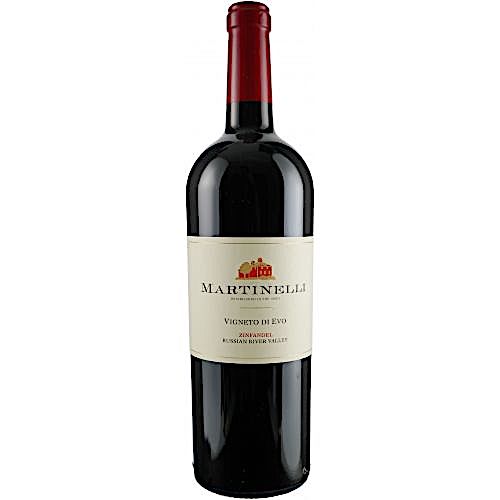
2017 Martinelli Zinfandel
“Vignato di’Evo” (40)—This is a full-bodied wine with a
bouquet and taste of ripe plums, cherries and
cedar wood, with hints of Asian spice in its big,
bold finish. It may be too full-bodied for some
but mates well with both spicy and sweet
fare.
2017 Primarius Pinot Noir ($15)—With grapes from an Oregon
vineyard featuring a cool climate but long sunny
days, this light-bodied wine shows a bouquet and
dry taste of cranberries, plums and cherries, with
a long smooth finish.
2018 Line 39 Pinot Noir ($10)—Light and elegant with a taste
and bouquet of raspberries, strawberries and
cherries and notes of earthy mushrooms in its
finish, this bargain bottle stands out from many
other similarly priced brands. In particular, it
makes particularly excellent accompaniment for
heady stuffing and the dark meat of turkey thighs
and drumsticks.
2018 Siduri Pinot Noir ($23)—This wine from Willamette Valley
in Oregon shows
a jammy bouquet and fresh taste of blackberries
and cranberries with hints of chocolate, bolder
than many Oregon Pinots but more typical for one
from California. But with its light body and soft,
dry finish it drinks more like a French Burgundy
than anything from California and mates
particularly well with starchy fare like sweet
potatoes and mushroom laced stuffing, bringing out
their earthy nuances.
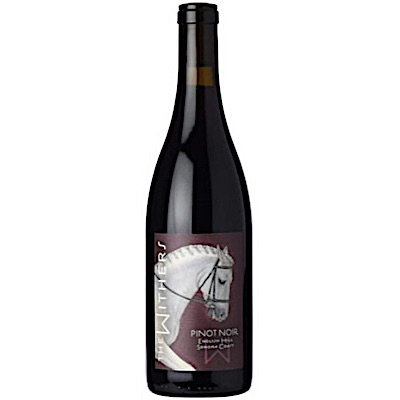
2018 Route Stock
“Route 116” Pinot Noir ($22)—This medium-bodied, easy-drinking
wine was made from grapes growing on a Sonoma
Coast vineyard that benefits from the cool breezes
off San Pablo Bay. It shows a bouquet and taste of
ripe cherries and raspberries and notes of sage in
its long lingering finish and is perfect to mate
with hors d’oeuvres and appetizers as well as main
course items and even desserts like rich pumpkin
pie.
2018 The Withers English Hill
Pinot Noir ($51)—While a bit on the pricey side,
compared with the other selections, this wine
delivers a rich floral bouquet and a full,
concentrated taste of cranberries, plums with
notes of fresh herbs in its long, smooth finish.
Not surprisingly, it enhances the taste of the
full range of Thanksgiving fare, from bland to
sharp cheeses to turkey and stuffing to the
classic green bean and mushroom soup casserole to
a range of desserts, like apple and pecan pies.
❖❖❖
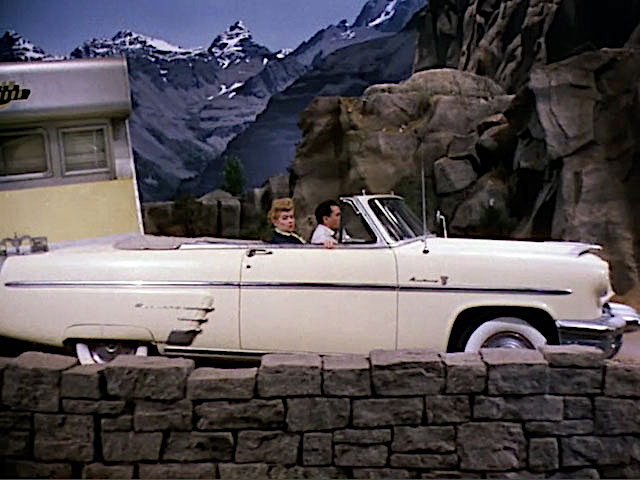
THINGS WE NEVER WOULD
HAVE THOUGHT OF BEFORE STARTING A ROAD TRIP
1. Map Your Route
2.
Find good food, cheap gas, and other points of
interest
3.
Book Accommodations in advance.
—"Everything You Need to Plan a Stress-Free Road Trip" by Ashley Halpern, Conde Nast Traveler (6/2020)
FOODS WE
NEVER THOUGHT OF TO AVOID FOR WEIGHT LOSS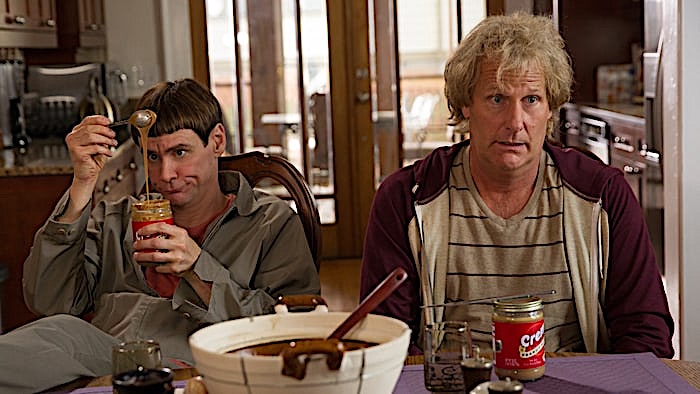
1. Candy
2. Ice
Cream
3. Soda
4. Potato
Chips
5.
Tortilla Chips
“15 Foods to Avoid for
Weight Loss”—Laurel Leicht, Men’s Journal
❖❖❖
Sponsored by

Any of John Mariani's books below may be ordered from amazon.com.
 The Hound in Heaven
(21st Century Lion Books) is a novella, and
for anyone who loves dogs, Christmas, romance,
inspiration, even the supernatural, I hope you'll find
this to be a treasured favorite. The story
concerns how, after a New England teacher, his wife and
their two daughters adopt a stray puppy found in their
barn in northern Maine, their lives seem full of promise.
But when tragedy strikes, their wonderful dog Lazarus and
the spirit of Christmas are the only things that may bring
his master back from the edge of despair.
The Hound in Heaven
(21st Century Lion Books) is a novella, and
for anyone who loves dogs, Christmas, romance,
inspiration, even the supernatural, I hope you'll find
this to be a treasured favorite. The story
concerns how, after a New England teacher, his wife and
their two daughters adopt a stray puppy found in their
barn in northern Maine, their lives seem full of promise.
But when tragedy strikes, their wonderful dog Lazarus and
the spirit of Christmas are the only things that may bring
his master back from the edge of despair. WATCH THE VIDEO!
“What a huge surprise turn this story took! I was completely stunned! I truly enjoyed this book and its message.” – Actress Ali MacGraw
“He had me at Page One. The amount of heart, human insight, soul searching, and deft literary strength that John Mariani pours into this airtight novella is vertigo-inducing. Perhaps ‘wow’ would be the best comment.” – James Dalessandro, author of Bohemian Heart and 1906.
“John Mariani’s Hound in Heaven starts with a well-painted portrayal of an American family, along with the requisite dog. A surprise event flips the action of the novel and captures us for a voyage leading to a hopeful and heart-warming message. A page turning, one sitting read, it’s the perfect antidote for the winter and promotion of holiday celebration.” – Ann Pearlman, author of The Christmas Cookie Club and A Gift for my Sister.
“John Mariani’s concise, achingly beautiful novella pulls a literary rabbit out of a hat – a mash-up of the cosmic and the intimate, the tragic and the heart-warming – a Christmas tale for all ages, and all faiths. Read it to your children, read it to yourself… but read it. Early and often. Highly recommended.” – Jay Bonansinga, New York Times bestselling author of Pinkerton’s War, The Sinking of The Eastland, and The Walking Dead: The Road To Woodbury.
“Amazing things happen when you open your heart to an animal. The Hound in Heaven delivers a powerful story of healing that is forged in the spiritual relationship between a man and his best friend. The book brings a message of hope that can enrich our images of family, love, and loss.” – Dr. Barbara Royal, author of The Royal Treatment.
 |
The Encyclopedia of American Food and Drink by John F. Mariani (Bloomsbury USA, $35) Modesty forbids me to praise my own new book, but let me proudly say that it is an extensive revision of the 4th edition that appeared more than a decade ago, before locavores, molecular cuisine, modernist cuisine, the Food Network and so much more, now included. Word origins have been completely updated, as have per capita consumption and production stats. Most important, for the first time since publication in the 1980s, the book includes more than 100 biographies of Americans who have changed the way we cook, eat and drink -- from Fannie Farmer and Julia Child to Robert Mondavi and Thomas Keller. "This book is amazing! It has entries for everything from `abalone' to `zwieback,' plus more than 500 recipes for classic American dishes and drinks."--Devra First, The Boston Globe. "Much needed in any kitchen library."--Bon Appetit. |
"Eating Italian will never be the same after reading John Mariani's entertaining and savory gastronomical history of the cuisine of Italy and how it won over appetites worldwide. . . . This book is such a tasteful narrative that it will literally make you hungry for Italian food and arouse your appetite for gastronomical history."--Don Oldenburg, USA Today. "Italian
restaurants--some good, some glitzy--far
outnumber their French rivals. Many of
these establishments are zestfully described
in How Italian Food Conquered the World, an
entertaining and fact-filled chronicle by
food-and-wine correspondent John F.
Mariani."--Aram Bakshian Jr., Wall Street
Journal.
"Equal parts
history, sociology, gastronomy, and just
plain fun, How Italian Food Conquered the
World tells the captivating and delicious
story of the (let's face it) everybody's
favorite cuisine with clarity, verve and
more than one surprise."--Colman Andrews,
editorial director of The Daily
Meal.com. "A fantastic and fascinating
read, covering everything from the influence
of Venice's spice trade to the impact of
Italian immigrants in America and the
evolution of alta cucina. This book will
serve as a terrific resource to anyone
interested in the real story of Italian
food."--Mary Ann Esposito, host of PBS-TV's
Ciao
Italia. "John Mariani has written the
definitive history of how Italians won their
way into our hearts, minds, and
stomachs. It's a story of pleasure over
pomp and taste over technique."--Danny Meyer,
owner of NYC restaurants Union Square
Cafe, The Modern, and Maialino.
|
 |
 |
 |
 |
 |
 |
 |
 |
 Everett Potter's Travel Report:
Everett Potter's Travel Report: 
 Eating Las
Vegas JOHN CURTAS has been covering
the Las Vegas food and restaurant scene
since 1995. He is the co-author of EATING LAS
VEGAS – The 50 Essential Restaurants (as
well as the author of the Eating Las
Vegas web site: www.eatinglasvegas.
He can also be seen every Friday morning as
the “resident foodie” for Wake Up With the
Wagners on KSNV TV (NBC) Channel 3 in
Las Vegas.
Eating Las
Vegas JOHN CURTAS has been covering
the Las Vegas food and restaurant scene
since 1995. He is the co-author of EATING LAS
VEGAS – The 50 Essential Restaurants (as
well as the author of the Eating Las
Vegas web site: www.eatinglasvegas.
He can also be seen every Friday morning as
the “resident foodie” for Wake Up With the
Wagners on KSNV TV (NBC) Channel 3 in
Las Vegas.
MARIANI'S VIRTUAL GOURMET
NEWSLETTER is published weekly. Publisher: John Mariani. Editor: Walter Bagley. Contributing Writers: Christopher Mariani,
Robert Mariani, Misha Mariani, John A. Curtas, Gerry Dawes, Geoff Kalish,
and Brian Freedman. Contributing
Photographer: Galina Dargery. Technical
Advisor: Gerry
McLoughlin.
If you wish to subscribe to this
newsletter, please click here: http://www.johnmariani.com/subscribe/index.html
© copyright John Mariani 2020

